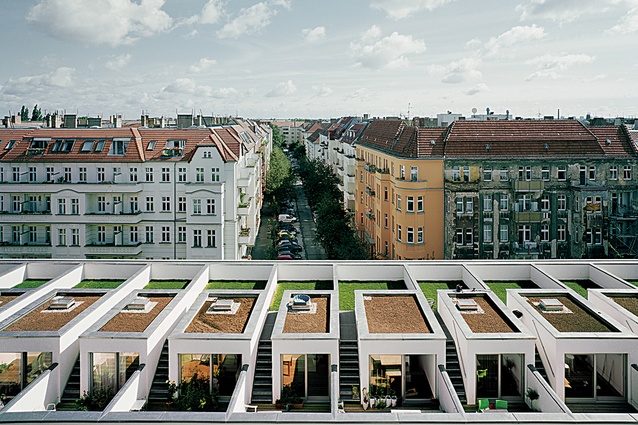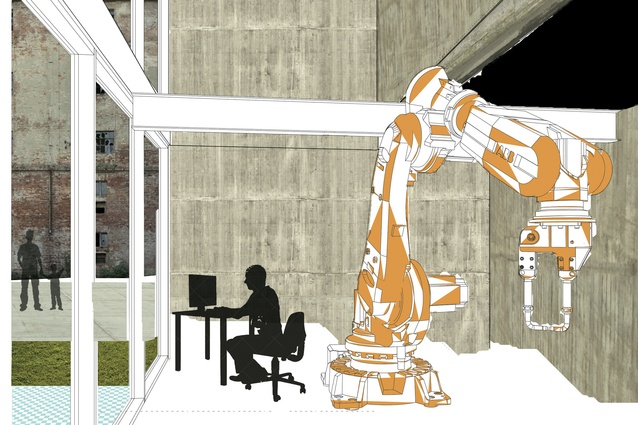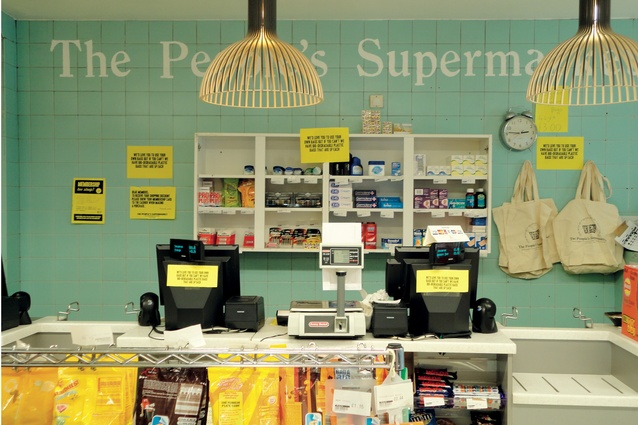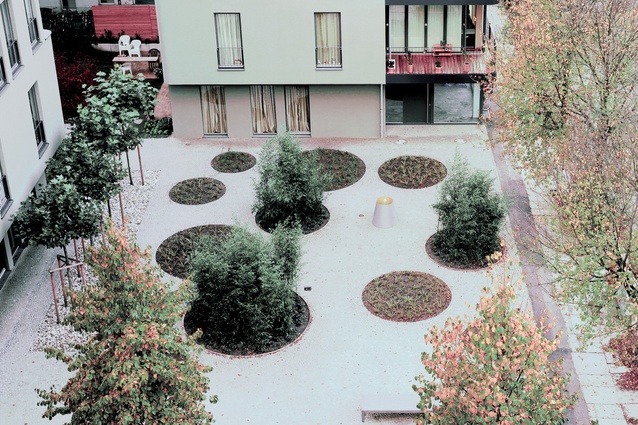Where is our collective imagination?
The concepts of co-housing and co-op housing lost their steam back in the 1970s but are now gaining popularity. With urban house prices so high, preventing many people from owning their own homes, the self-funded co-housing model could be an antidote to the market-driven developer model.
In this article from a 2014 issue of Architecture New Zealand, Dominic Glamuzina from Glamuzina Architects and Aaron Paterson from PAC explain.
Many New Zealanders would rather add an extra couple of metres onto their entry gates than share anything with their neighbours. For more community-minded souls, the development of co-housing communities, together with broader ideas of urban cooperatives, offers an opportunity for them to truly connect with the built environment in a more sustainable way.

Teddy Cruz, known for his urban research on the Tijuana/San Diego border, began his Communiqué 2013 lecture with the question, “Where is our collective imagination?” According to Cruz, one place we can find the answer is in the radical, informal and local interventions borne from “progressive, community-based, non-profit organisations” and not from private development or government. “The slums of Tijuana can teach a lot to the sprawl of San Diego,” says Cruz.
His research describes ingenious retrofitted neighbourhoods, where housing is not just built as units but plugged into existing social and economic systems, allowing opportunities to combine housing with informal economies. The ‘one house, one lawn’ model gives way to parcels of shared land, where cross-programming is possible and density is redefined as social exchanges per acre.
What interested us in Cruz’s research, beyond the leftist sentiment, was an understanding that a successful housing project is more than just bold design; it is what you programme into it, what existing social and economic networks you plan for the scheme to tap into and, most importantly, what effect the design will have as a social condenser.
You have to wonder what happened to the bold medium-density housing of the ’70/’80s, like Athfield Architects’ Pearce Apartments and Claude Megson’s Wood Street Townhouses that recently won an enduring architecture award. These village-like clusters visually express a belief that a building should be flexible and adapt to the changing needs of the occupants.
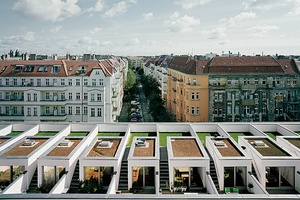
We believe solutions to the housing crisis should be spatially and ideologically bold and follow a movement towards flexibility that adds community connectedness, challenges loneliness and embraces the sharing economy. Co-housing is one of many alternatives worth considering; as Jeremy Till has said, “We need to be investigating new models for flexible living… Co-housing… [is]… a fantastic model because it means you could share a big dining room or a spare bedroom or equipment… Property developers are obsessed with giving everyone homes with lots of tiny, unusable rooms when what we really need is larger, shared spaces.”
A co-housing community is made up of private homes that are enhanced by shared facilities. Co-housing does not mean a commune, where everything is owned by the group; it’s certainly not an ashram or kibbutz but it does involve a degree of its residents having shared values. The extent of sharing depends on how the financial and maintenance negotiations are established. The structure is often a freehold title and owned by a company set up by residents, where individuals purchase leasehold houses and become company directors.
The co-housing idea originated in Denmark and it is estimated that eight per cent of Danish households are co-housing, typically sharing facilities like childcare facilities, gardens and kitchens. In the UK, there has been a swelling of interest in co-housing, not just from the alternative lifestyle ilk but from more mainstream families and professionals. Organisations like the UK Cohousing Network have been established to place compatible people in touch with each other.

Overseas models have emerged from cultures where organisational, legislative and, importantly, bank-lending frameworks exist to facilitate alternative housing outcomes. This isn’t reason to despair; it conveniently means we don’t have to reinvent the wheel and we can add New Zealand nuances. There are a few established co-housing developments in New Zealand and these are usually based on a shared belief in social and environmental sustainability.
Another local model is Papakainga housing, or village housing on Maori or ancestral land, owned by multiple people. Such schemes have been developed through local and regional organisations coming together to create housing solutions and communities. Traditionally, these developments have been connected to marae but other programs have developed to bolster the community, including kohanga reo, kura kaupapa, health clinics, horticulture or agriculture, sports and/or recreational areas, urupa and heritage sites.
In Germany, the Baugruppen phenomenon of like-minded house-hunters forming collectives to self-finance and develop their own affordable, multi-family projects has challenged traditional procurement. Whereas most co-housing projects have been suburban/rural developments, the Baugruppen is more urban in character. It is the result of families finding creative ways to stay in the expensive inner city, rather than being forced to move to the less-expensive outer suburbs because that’s what they can afford.
To do this, the groups had to be involved in a collaborative process, engage architects and make plans specific to their needs. The result is an architecture of sharing, whereby informal encounters are encouraged and designed into the schemes.

A diversity of design solutions that are shared between residents include: shared workshop, cinema, adaptive reuse of existing structures, roof garden where a penthouse would normally be sited, childcare facilities, library, quiet office space, a shared bedroom for guests (this reduces the footprint in comparison with everyone having a spare room), and the option for communal kitchen and dining. At ground level, there are shared gardens and sheds, play areas for kids and shared toilets, so if you are playing downstairs, you don’t have to return to your apartment.
Although these programmes appear in developer-driven schemes, Baugruppen projects are not driven by investment return and are specific to the users; this makes the shared aspects of the schemes more powerful. The effect on the character of the city is positive, with people committed to a neighbourhood wanting to buy a stake in the area, along with the added sense of community that is engendered with co-housing.
Although these schemes are altogether more bourgeois than is social housing, they do offer antidotes to the banal rental gentrification of the inner city that developers dish up. It also offers architects a role in facilitating co-housing outcomes.
HOMEWORK co-housing studio at The University of Auckland
An interest in the potential of co-housing, alongside the belief that architecture is a social condenser, manifests itself in a design studio we taught at The University of Auckland [in 2013]. HOMEWORK studio set out to challenge traditional ideas of the domestic sphere through an interrogation of how we live and work and how these two programmes might combine. In other fields, such as workplace and education, shared social spaces have become common. Unfortunately, there has not been the same level of exploration in our local domestic/private ownership market.
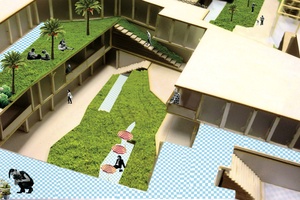
The co-housing intervention was in the urban environment on the vacant site on the corner of Auckland’s Karangahape Road and Gundry Street. Students produced projects similar to Allan Wild’s description of Ian Athfield’s buildings as “happenings for inhabiting”. He stated, “Houses have been shattered into happenings… they are not designed as general expressions of ideas about how people might live − they are snock-cocking non-buildings, hippie happenings for inhabiting… They are altogether human, loveable, improbable and irresponsible.”
Three students in the studio covered different needs within co-housing: Tessa Forde addressed multi-generational requirements, such as grandparents raising grandchildren within the home; William Brooks explored the creation of an urban factory which brings industry linked to housing back to the city; while Ye Jin Yoon designed a residence for a group of young couples with children, which is laid out with a shared communal learning centre at ground-floor level.
Although our university work is speculative, it does offer up ideas about how cooperative principles could develop within the New Zealand context as viable solutions to housing affordability and urban development. With the current discussions about denser housing under the Unitary Plan, there needs to be a wider discourse about how we can enable self-funded models as antidotes to the market-driven developer model. How could these models work within a New Zealand context?
Cooperatives work within rural and suburban environments but it is within urban environments that they could have the most value as models for how we want our cities to develop as viable alternatives to suburban sprawl. Developing cooperative models in urban areas provides the opportunity not only to add to the specific housing models, but to propose alternatives to commercial development and public spaces.
Examples such as ru43 by Zanderroth Architekten in Berlin-Mitte not only created shared spaces for the inhabitants but also included a public park as part of the design of the apartments.

In order to be successful, cooperative housing needs to be concerned specifically with both its own community and the neighbourhood within which it is located. It provides an opportunity to address the needs of the wider community by creating housing and businesses that are specific and connected to the local context.
An urban cooperative is able to include retail space as part of its ground-floor development, which could generate income for the cooperative and also create spaces that reflect the requirements of the city. The concept becomes not about maximising leasable space but understanding the requirements of the community and developing a flexible and affordable model which encourages small-scale business, such as Wisselwinkel (‘shift shop’) in Amsterdam, a retail space that hosts a new local entrepreneur every six months.
Other cooperative business models, such as The People’s Supermarket located in Bloomsbury, London, is located amongst a mixture of public and private housing on a street that has its fair share of franchise retail space. The supermarket was set up as a food cooperative in which the members receive a 20 per cent discount off food and have a say in both how the business is run and what food is stocked on the shelves. These types of businesses form a resistance to gentrification in urban spaces by providing a bottom-up model that is driven by the requirements of the local community.
‘Scale’ becomes an important factor in the success of any form of cooperative but size can be both a strength and a weakness. Finding consensus among large collective organisations can be a long and difficult task, as anyone will understand who lives in an apartment and belongs to a body corp.
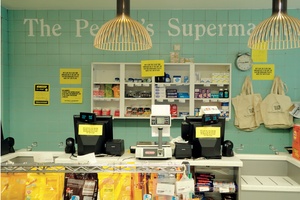
But, unlike with a body corporate, finding consensus can be achieved when like-minded people are involved. Cooperatives don’t need to be big to be successful and, within the New Zealand context, smaller (five to 10 apartments) would be more achievable and reflect the scale of our urban environment. Scale, however, has advantages in terms of the capacity to influence planning regulations and financial requirementsin favour of the cooperative.
Cooperatives shouldn’t be seen only as a way for the middle class to create affordable housing but should be able to provide solutions for specific age, cultural and socio-economic groups through public funding, iwi housing initiatives and bank loans. Diversity should be an imperative in cooperative housing initiatives. By taking advantage of collective economic capacity and bypassing the developers’ requirement for profit, cooperatives provide the perfect opportunity for inventive solutions for specific groups.
How will this work in New Zealand?
The co-operative proposes a bottom-up, specific response to the city; a small-scale community that is able to elicit specificity as the basis for creating connected community environments. It will, however, require a different way of thinking about how we plan and develop our cities for housing.
New Zealand will need to create different financing models specific to local requirements and there are opportunities (such as in Auckland’s Unitary Plan) to join sections together to develop land for co-housing. Government and councils will need to create the framework that enables a group of individuals greater time during the purchasing process to buy a site as a collective.
The role of the architect will be closer to that of a counsellor/facilitator, involving considerable joint consultation, especially in terms of resolving spatial relationships. Clearly, there are many issues that will need addressing but with clever thinking and the support of government, it would be well worth the effort if we can create cohesive communities focused on long-term sustainability.
See here for an article on a radical new participatory model for commercial property development in Christchurch.

